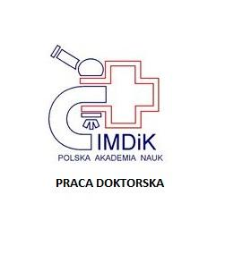- Wyszukaj w całym Repozytorium
- Piśmiennictwo i mapy
- Archeologia
- Baza Młynów
- Nauki przyrodnicze
Wyszukiwanie zaawansowane
Wyszukiwanie zaawansowane
Wyszukiwanie zaawansowane
Wyszukiwanie zaawansowane
Wyszukiwanie zaawansowane

Obiekt
Tytuł: Badanie mechanizmów ekscytotoksyczności w ostym toksycznym działaniu tetrabromobisfenolu A na komórki ziarniste móżdżku szczura w hodowli pierwotnej
Współtwórca:
Ziemińska, Elżbieta (Promotor)
Wydawca:
Instytut Medycyny Doswiadczalnej i Klinicznej im. Miroslawa Mossakowskiego PAN
Miejsce wydania:
Opis:
Bibliogr. na str. 132-158 ; 158s.: tabl., wykr., fotogr. ; 30cm
Uzyskany tytuł:
Stopień studiów:
Dyscyplina :
Abstrakt:
Tetrabromobisfenol A (TBBPA) jest bromowanym opóźniaczem spalania powszechnie stosowanym w przemyśle przy produkcji urządzeń elektrycznych, tekstyliów, mebli, wyposażania samochodów i samolotów, a także budownictwie. Pomimo zapewnień technologów, że TBBPA jest związkiem trwale wiążącym się z produktem i przez to bezpiecznym, wykazano jego obecność w środowisku, a także w próbkach tkanek i płynów ustrojowych człowieka i zwierząt. Hydrofobowość i wysoka lipofilność TBBPA ułatwia pokonywanie błon i barier biologicznych i wnikanie do narządów i komórek. Ekspozycja na TBBPA może następować drogą oddechową, przez kurz, oraz pokarmową, przez zanieczyszczoną wodę i żywność. Badania wykazały zależne od stężenia TBBPA zjawiska; [Ca2+]i, indukcję stresu oksydacyjnego, którego wskaźnikami były wzrost produkcji wolnych rodników tlenowych (ROS), oraz spadek stężenia glutationu (GSH) i aktywność katalazy, a także depolaryzację mitochondriów w CGC. Zahamowanie wzrostu [Ca2+]i przez podanie antagonistów NMDAR i receptorów rianodynowych (RyR) zapobiegło wywołanej przez 10 µM TBBPA indukcji stresu i depolaryzacji mitochondriów, natomiast te efekty indukowane przez 25 µM były tylko częściowo hamowane Te wyniki po raz pierwszy bezpośrednio udowodniły , że wzrost [ Ca2+]i, zachodzący za pośrednictwem NMDAR i receptorów rainodynowych (RyR), odgrywa kluczową i pierwotną rolę w patogenezie indukowanego przez TBBPA stresu oksydacyjnego przez 25 µM TBBPA. Dalsze eksperymenty po raz pierwszy ujawniły, że TBBPA obniża potencjał błonowy neuronów, co więcej, w tym zjawisku biorą udział zarówno jonotropowe receptory glutaminianu (NMDAR I AMPAR), jak i kanały sodowe bramkowane napięciem. Ta ostatnia informacja daje podstawy dla hipotezy, że depolaryzacja CGC eksponowanych na TBBPA, jeśli jest po części zjawiskiem pierwotnym, może sprzyjać aktywacji kanału NMDAR przez zniesienie bloku magnezowego. Testowana była także hipoteza, że aktywacja NMDAR w CGC eksponowanych na TBBPA może być wynikiem zahamowania pobierania zwrotnego glutaminianu, co [prowadzi do wzrostu jego stężenia w środowisku zewnątrzkomórkowym. Wyniki badań niniejszej pracy, wskazują na decydujący udział ekscytotoksyczności w mechanizmach działania TBBPA na CGC w hodowli pierwotnej. Kluczową rolę tych złożonych i wzajemnie na siebie działających mechanizmach komórkowych odgrywa wzrost [Ca2+]i w którym pośredniczą NMDAR i RyR ], prowadzący do indukcji stresu oksydacyjnego i deenergizacji mitochondriów. Elementem zewnątrzkomórkowym tego mechanizmu domykającym błędne koło ekscytotoksyczności jest wzrost stężenia endogennego glutaminianu, prowadzący do aktywacji NMDAR i AMPAR.
Czasopismo/Seria/cykl:
Szczegółowy typ zasobu:
Identyfikator zasobu:
Źródło:
IMDiK PAN, sygn. ZS 402 ; kliknij tutaj, żeby przejść
Język:
Prawa:
Licencja Creative Commons Uznanie autorstwa 4.0
Zasady wykorzystania:
Zasób chroniony prawem autorskim. [CC BY 4.0 Międzynarodowe] Korzystanie dozwolone zgodnie z licencją Creative Commons Uznanie autorstwa 4.0, której pełne postanowienia dostępne są pod adresem: ; -
Digitalizacja:
Instytut Medycyny Doświadczalnej i Klinicznej im. M. Mossakowskiego Polskiej Akademii Nauk
Lokalizacja oryginału:
Biblioteka Instytutu Medycyny Doświadczalnej i Klinicznej im. M. Mossakowskiego PAN
Dofinansowane ze środków:
Dostęp:
Kolekcje, do których przypisany jest obiekt:
- Repozytorium Cyfrowe Instytutów Naukowych > Kolekcje Partnerów > Instytut Medycyny Doświadczalnej i Klinicznej PAN > Prace dyplomowe > Prace doktorskie
- Repozytorium Cyfrowe Instytutów Naukowych > Piśmiennictwo > Prace dyplomowe
Data ostatniej modyfikacji:
5 sty 2023
Data dodania obiektu:
6 lis 2020
Liczba pobrań / odtworzeń:
728
Wszystkie dostępne wersje tego obiektu:
https://rcin.org.pl./publication/182071
Wyświetl opis w formacie RDF:
Wyświetl opis w formacie RDFa:
Wyświetl opis w formacie OAI-PMH:
| Nazwa wydania | Data |
|---|---|
| Diamandakis, Dominik | 5 sty 2023 |
Obiekty Podobne
Ji, Benjun
Skowrońska, Katarzyna
Łazarewicz, Jerzy
Łazarewicz, Jerzy W. Salińska, Elżbieta

 INSTYTUT ARCHEOLOGII I ETNOLOGII POLSKIEJ AKADEMII NAUK
INSTYTUT ARCHEOLOGII I ETNOLOGII POLSKIEJ AKADEMII NAUK
 INSTYTUT BADAŃ LITERACKICH POLSKIEJ AKADEMII NAUK
INSTYTUT BADAŃ LITERACKICH POLSKIEJ AKADEMII NAUK
 INSTYTUT BADAWCZY LEŚNICTWA
INSTYTUT BADAWCZY LEŚNICTWA
 INSTYTUT BIOLOGII DOŚWIADCZALNEJ IM. MARCELEGO NENCKIEGO POLSKIEJ AKADEMII NAUK
INSTYTUT BIOLOGII DOŚWIADCZALNEJ IM. MARCELEGO NENCKIEGO POLSKIEJ AKADEMII NAUK
 INSTYTUT BIOLOGII SSAKÓW POLSKIEJ AKADEMII NAUK
INSTYTUT BIOLOGII SSAKÓW POLSKIEJ AKADEMII NAUK
 INSTYTUT CHEMII FIZYCZNEJ PAN
INSTYTUT CHEMII FIZYCZNEJ PAN
 INSTYTUT CHEMII ORGANICZNEJ PAN
INSTYTUT CHEMII ORGANICZNEJ PAN
 INSTYTUT FILOZOFII I SOCJOLOGII PAN
INSTYTUT FILOZOFII I SOCJOLOGII PAN
 INSTYTUT GEOGRAFII I PRZESTRZENNEGO ZAGOSPODAROWANIA PAN
INSTYTUT GEOGRAFII I PRZESTRZENNEGO ZAGOSPODAROWANIA PAN
 INSTYTUT HISTORII im. TADEUSZA MANTEUFFLA POLSKIEJ AKADEMII NAUK
INSTYTUT HISTORII im. TADEUSZA MANTEUFFLA POLSKIEJ AKADEMII NAUK
 INSTYTUT JĘZYKA POLSKIEGO POLSKIEJ AKADEMII NAUK
INSTYTUT JĘZYKA POLSKIEGO POLSKIEJ AKADEMII NAUK
 INSTYTUT MATEMATYCZNY PAN
INSTYTUT MATEMATYCZNY PAN
 INSTYTUT MEDYCYNY DOŚWIADCZALNEJ I KLINICZNEJ IM.MIROSŁAWA MOSSAKOWSKIEGO POLSKIEJ AKADEMII NAUK
INSTYTUT MEDYCYNY DOŚWIADCZALNEJ I KLINICZNEJ IM.MIROSŁAWA MOSSAKOWSKIEGO POLSKIEJ AKADEMII NAUK
 INSTYTUT PODSTAWOWYCH PROBLEMÓW TECHNIKI PAN
INSTYTUT PODSTAWOWYCH PROBLEMÓW TECHNIKI PAN
 INSTYTUT SLAWISTYKI PAN
INSTYTUT SLAWISTYKI PAN
 SIEĆ BADAWCZA ŁUKASIEWICZ - INSTYTUT TECHNOLOGII MATERIAŁÓW ELEKTRONICZNYCH
SIEĆ BADAWCZA ŁUKASIEWICZ - INSTYTUT TECHNOLOGII MATERIAŁÓW ELEKTRONICZNYCH
 MUZEUM I INSTYTUT ZOOLOGII POLSKIEJ AKADEMII NAUK
MUZEUM I INSTYTUT ZOOLOGII POLSKIEJ AKADEMII NAUK
 INSTYTUT BADAŃ SYSTEMOWYCH PAN
INSTYTUT BADAŃ SYSTEMOWYCH PAN
 INSTYTUT BOTANIKI IM. WŁADYSŁAWA SZAFERA POLSKIEJ AKADEMII NAUK
INSTYTUT BOTANIKI IM. WŁADYSŁAWA SZAFERA POLSKIEJ AKADEMII NAUK




































